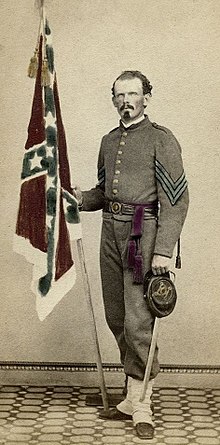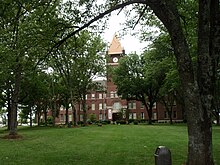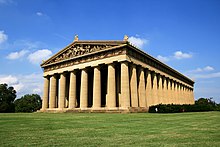William Crawford Smith
William Crawford Smith | |
|---|---|
 | |
| Born | November 26, 1837 Petersburg, Virginia, U.S. |
| Died | February 5, 1899 (aged 61) Manila, Philippines |
| Resting place | Mount Olivet Cemetery |
| Occupation | Architect |
| Military career | |
| Allegiance | |
| Service/ | Confederate States Army United States Army |
| Years of service | 1861–1865 (CSA) 1898–1899 (USA) |
| Rank | |
| Battles/wars | American Civil War Philippine–American War |
William Crawford Smith (November 26, 1837 – February 5, 1899) was an American architect who served in the Confederate States Army during the American Civil War and in the United States Army during the Philippine–American War. He designed many buildings in Nashville, Tennessee, including Kirkland Hall, the first building on the campus of Vanderbilt University, and the Parthenon in Centennial Park.


Early life
William Crawford Smith was born on November 26, 1837, in Petersburg, Virginia.[1][2] He moved to Nashville, Tennessee in the 1850s.[2]
During the

Career
After the war, Smith was an architect in Nashville, Tennessee.[1] In 1874, he designed the Main Building of Vanderbilt University, later known as Kirkland Hall, as two French Gothic towers.[4][5] The building burnt down in a fire in 1905, and it was later rebuilt with only one tower.[5]
Smith designed the Collier-Crichlow House in Murfreesboro, Tennessee in 1880 for Ingram Banks Collier III, who served as the mayor of Murfreesboro from 1872 to 1873.[6] It was listed on the National Register of Historic Places on July 16, 1973.[7]
Smith was commissioned to design the Masonic Temple in Columbia, Tennessee in 1883.[8] A decade later, in 1893, Smith designed the Colemere Mansion in Nashville for Confederate Colonel Edmund William Cole, who served as the President of the Nashville, Chattanooga and St. Louis Railway after the war. The house burnt down in October 1929.[9] Meanwhile, Smith designed Memorial Hall on the campus of Cumberland University in Lebanon, Tennessee, built from 1892 to 1896.[10]
Additionally, Smith was commissioned to two buildings in
Meanwhile, in 1897, Smith designed The Parthenon in Centennial Park.[12][13]
Smith quit his architectural career to serve in the Philippine–American War, where he commanded the 1st Tennessee Infantry Regiment of the United States Army in 1898–1899.[14]
Personal life
Smith was married.[2] They had several children, including a son, George J. Smith, who also served in the Philippine–American War,[15] and a daughter, who married Hart B. Blanton.[2]
Smith was a Knight Templar.[16]
Death and legacy
Smith died of heat exhaustion during the
In 1903, an honorary plaque from the Nashville Red Cross Society was installed inside the Parthenon.[2] The ceremony was attended by Benton McMillin, who served as the governor of Tennessee from 1899 to 1903.[2]
The Parthenon has been listed on the National Register of Historic Places in Davidson County since February 23, 1972. Memorial Hall has been listed on the National Register of Historic Places in Wilson County since April 29, 1977.[20] Meanwhile, one of Smith's apprentices, Clarence Kelley Colley, went on to become a renowned architect in his own right, with buildings listed on the National Register of Historic Places.[21]
References
- ^
- ^
- ^ Henderson, William D. (1984). 12th Virginia Infantry, The Virginia Regimental History Series. Petersburg, VA: H. E. Howard Inc.
- ^ ISBN 9781596294042.
- ^ Harber, Susan (March 18, 2017). "Collier-Crichlow-Smythe House's beauty shines through years". Rutherford County Tennessee Historical Society. Retrieved December 13, 2017.
- ^ "Collier-Crichlow House". National Park Service. United States Department of the Interior. Retrieved December 13, 2017.
- ISBN 9781625843067.
- ISBN 9780870498817.
- ^
- JSTOR 42626877.
- ^ a b Baxter, Colin F. "Spanish–American War". The Tennessee Encyclopedia of History and Culture. Tennessee Historical Society & University of Tennessee Press. Retrieved November 23, 2015.
- ^
- ^ "Memorial Hall, Cumberland University". National Park Service. Retrieved November 23, 2015.
- ^ Adgent, Nancy L. "Clarence Kelley Colley (1868–1956)". The Tennessee Encyclopedia of History and Culture. Tennessee Historical Society & University of Tennessee Press. Retrieved November 23, 2015.
